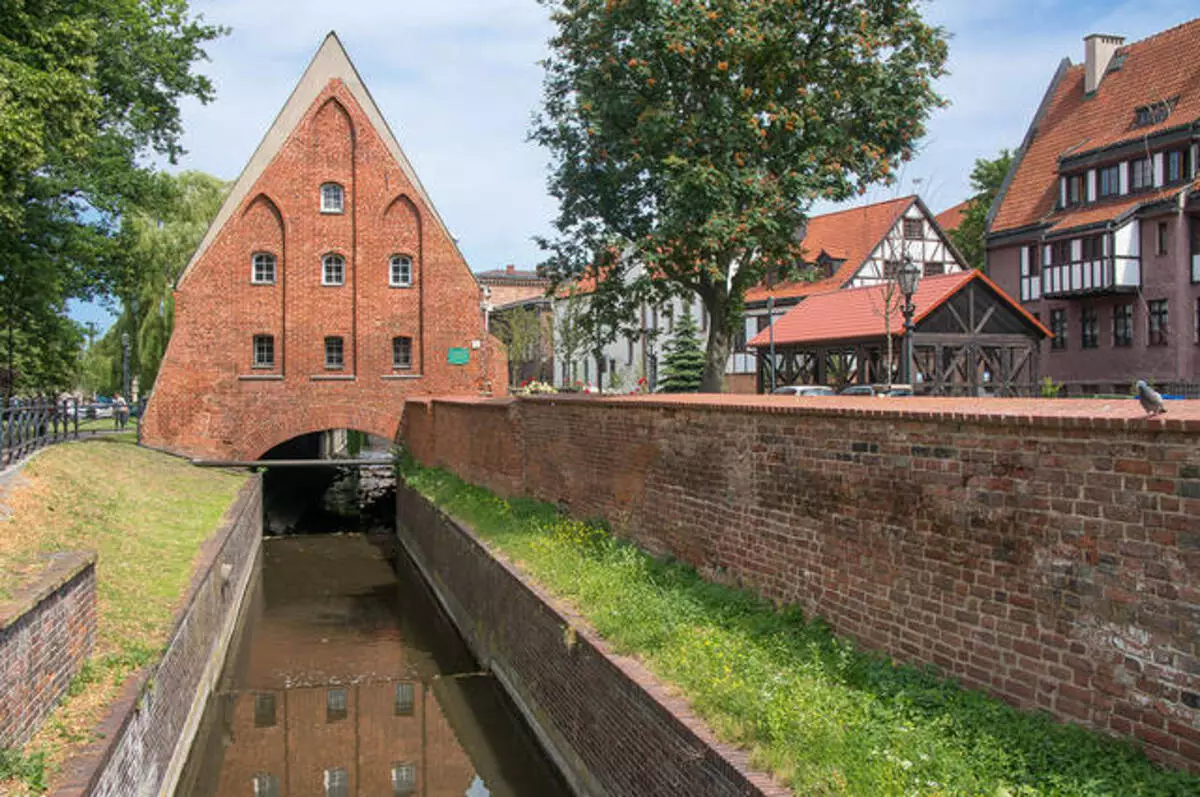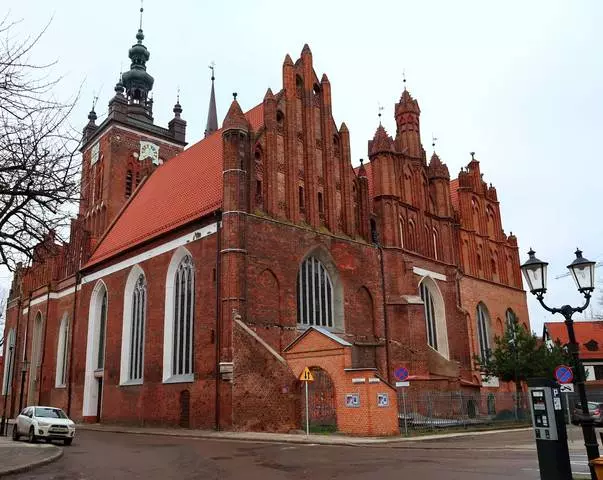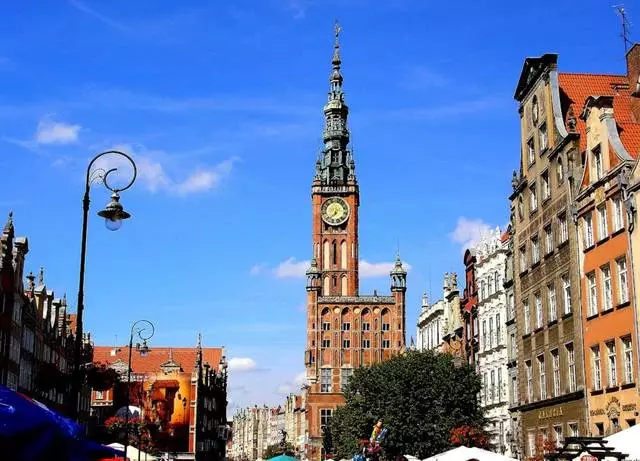Wikipedia states that it is not necessary to expect a medieval antiquity from the beautiful Polish city of Gdansk, since he suffered very much during World War II. But it's hard to agree with this, because at least many buildings are here and are new things, and everything that can be seen here, in any case, much of that was created literally from scratch after 1945, but it was still a recreated lost architecture and she carefully persisted in its original form. So we can say that from all Baltic cities Gdansk is perhaps the most bright and memorable.
You can start the view of the city, for example, with a small mlyna, because there is a rare for this city the opportunity to park your car. Opposite the Small Mlyna is large and he essentially takes on all the attention, but the youngest brother does not often notice. In general, this is a former granary that you can see almost only the facade, according to which it seems that it is compact and fragile. But, if you go to him from the side of the church of St. Catherine and look at him on the side, then in essence he will be not so small. In principle, never in essence he was not a mill, and why he wears such a strange name remains a mystery. The building is very old and officially it was built in the fourteenth century. This is actually the island of silence and calm in such a noisy and crowded city as Gdansk.

Further, in front of it, there is a large mlyn with 18 water wheels and six floors of the repository, its prototype was built in 1350, well, a copy was recreated by the post-war time. Initially, this mill was built by crusaders, however, as almost every second sight of Gdansk city. Even in the period of endless disassembly between Poland and Prussia, the big Mlyn was repeatedly burned, and then raised the ruins again. So it can be said that this mill has changed its appearance about once in a century. The building has very impressive dimensions and architectural style. Nearby is a scholar, where citizens are going to relax. Nowadays, large Mlyn is mainly used as a shopping center, and the inner premises were specifically rebuilt under shopping pavilions.
Church of St. Catherine is indicated on the map as a museum of hours and as an observation deck. It was built in honor of Catherine Alexandrian, but in 1944 the tower of this church was almost completely destroyed, well, the inner decoration was almost looted. It remains only that it was physically impossible to drain, that is, the tombstone of Polish astronoma Yana Gevelia. At the museum, if possible, it is worth noting, because there is an unusually wonderful collection of watches, ranging from the most vintage and up to the ultra-modern.

Not far from the Church of St. Catherine is simply a diva-wonder - language school, which is essentially not included in the rated attractions, and there is no additional information about it. But it is in vain, because the building is completely outstanding - a very motley and green spot right in the city center. Further, on Panskaya Street, you need to move towards a big arsenal. In the tourist season, of course, tourists here are extraordinarily many. Next, you need to go through the defensive ring Gdansk. Here you will see the ruins of the fortress walls that are in perfect decline. And finally you will find yourself opposite the big arsenal. It was built in the seventeenth century in the architectural style of the classic Renaissance, in general, the building is incredibly beautiful. Up to the end of the nineteenth century, it was engaged in performing his own direct function, that is, they were kept here and stored weapons. Now there is a shop here on the first floor, and on all the upper floors, the Academy of Fine Arts.

There is perhaps the most extraordinary monument dedicated to the friendship of peoples in the world between the large arsenal and the gold gate. It is called the "Millennium Tree", and the creator of him is Kuznets Leonard Ange Dykovski. This monument was installed on a small area in honor of the 1000th anniversary of Gdansk, and that is noteworthy - the tree grows almost every year per twig. All his new elements are brought from different parts of our planet and are attached to the design of the monument. There are already oak branches on the tree, maple, and then butterflies, mermaid, peacock, spiders and lizards. Australia, Britain, Africa, and, of course, Poland already contributed to the design of this tree.
Next, you need to dive into the golden gate in order to get to the most popular tourist street Gdansk, which wears the uncomplicated name - the long market. If you carefully look at the houses on this street, we can see that they seem to be glued together, because there are no lumen and no passages. It is noteworthy that there are exchanger and restaurants behind these buildings, but in order to get there, you need to completely get around two rows of houses.
The houses are surprisingly bright and beautiful, which undoubtedly raises the mood immediately to all tourists. And you still need to notice that Gdansk is beautiful almost always, even when it rains. At the end of the street, you can remove the high spire with a clock at the top - this is a city town hall. If you go upstairs, there is an observation deck and a museum, it is necessary to pay only 12 zł for the entrance. If there is time, then you must notice there. The collection of this museum was completely exported from the country for storage during the war, so everything that is presented here is genuine. But the Town Hall itself, of course, is a copy, and she is not even 50 years old.

Further along the path of your research, you will see the courtyard of Artus, which is closely pressed the stone buildings closely - the house of economist, the new and old houses of benches and also the courtyard of Artus. This is the center of the secular and merchant life of the city of Gdansk, which was founded in the fourteenth century. For the second world war, he, of course, survived with losses, was then reconstructed. There were balls in ancient times, auctions were arranged, and in the middle of the eighteenth century there was a stock exchange. Today, this place has a museum with rather valuable exposures - an old oven with images of Polish kings, with ancient ships, life of life and works of art.
Opposite the court of Artus, you will see the Neptune Fountain, which is a strange symbol of Gdansk. Initially, there was a well on this place, but the view of him was unsightly, and sometimes even frightening. So he stood, stood and strongly annoyed citizens and merchants coming to visit. However, at one fine moment, their patience came end, and at the beginning of the seventeenth century decided to replace this wretched hole on the pompous and very graceful figure of the Divine, which was cast in Bavaria and installed on Square in 1633. The Second World War Fountain survived, but not entirely.

The Church of the Virgin Mary is the most, perhaps, the main attraction in the city of Gdansk. This is one of the largest cathedrals of Europe, not to mention at all about the Baltic region, because its length is 105 meters, and it accommodates 25,000 people immediately. The construction of the cathedral began in 1343, but it was built almost over 150 years. The main architectural style is Gothic. This is perhaps the only sight of the old Gdansk, which is actually the original. During World War II, the roof was defeated here and one of the walls collapsed. But the reconstruction produced in 1947 made it possible to fully preserve the national heritage of the former Prussia, but already within the framework of the Polish Republic.
